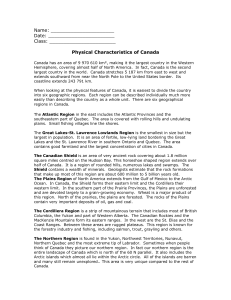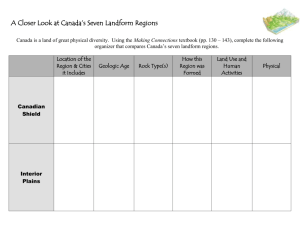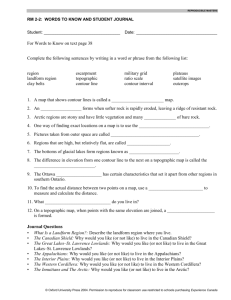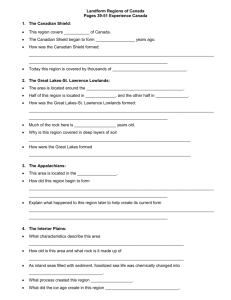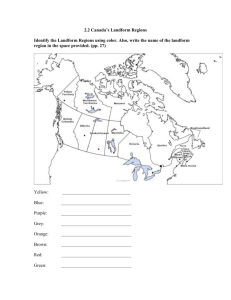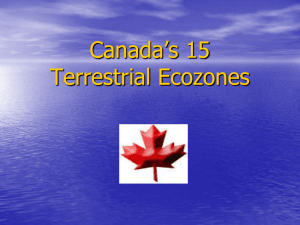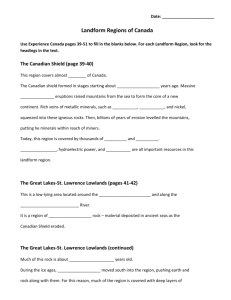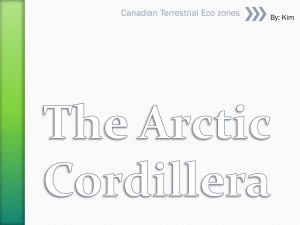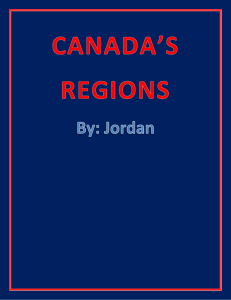Landforms of Canada - Woodroffe High School
advertisement
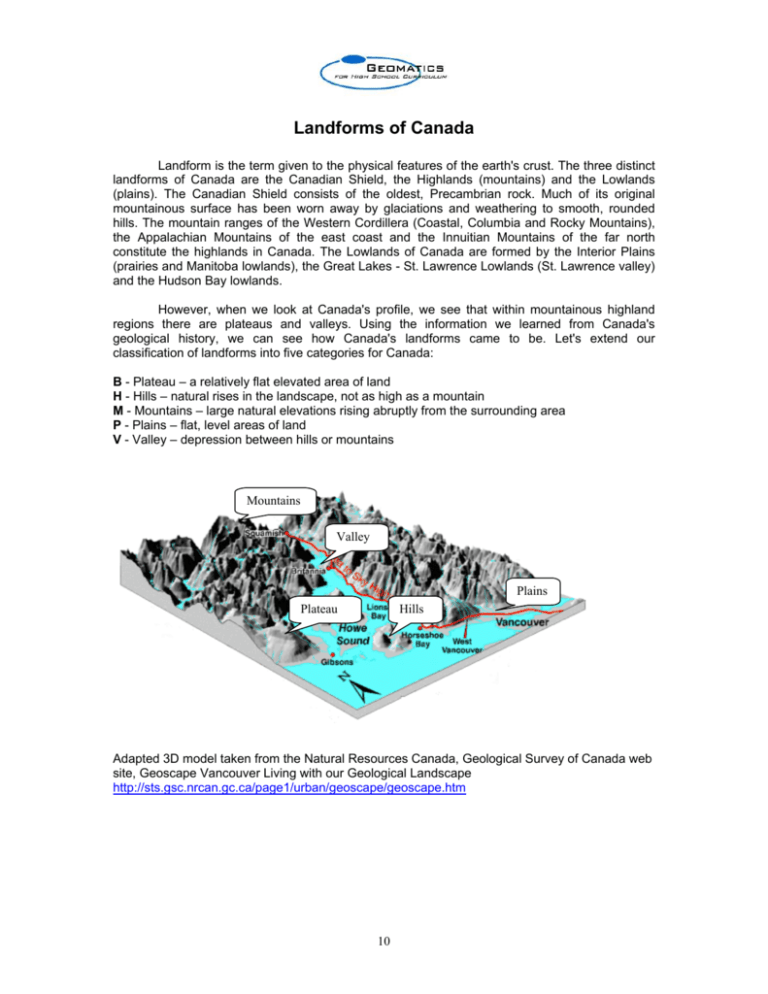
Landforms of Canada Landform is the term given to the physical features of the earth's crust. The three distinct landforms of Canada are the Canadian Shield, the Highlands (mountains) and the Lowlands (plains). The Canadian Shield consists of the oldest, Precambrian rock. Much of its original mountainous surface has been worn away by glaciations and weathering to smooth, rounded hills. The mountain ranges of the Western Cordillera (Coastal, Columbia and Rocky Mountains), the Appalachian Mountains of the east coast and the Innuitian Mountains of the far north constitute the highlands in Canada. The Lowlands of Canada are formed by the Interior Plains (prairies and Manitoba lowlands), the Great Lakes - St. Lawrence Lowlands (St. Lawrence valley) and the Hudson Bay lowlands. However, when we look at Canada's profile, we see that within mountainous highland regions there are plateaus and valleys. Using the information we learned from Canada's geological history, we can see how Canada's landforms came to be. Let's extend our classification of landforms into five categories for Canada: B - Plateau – a relatively flat elevated area of land H - Hills – natural rises in the landscape, not as high as a mountain M - Mountains – large natural elevations rising abruptly from the surrounding area P - Plains – flat, level areas of land V - Valley – depression between hills or mountains Mountains Valley Plains Plateau Hills Adapted 3D model taken from the Natural Resources Canada, Geological Survey of Canada web site, Geoscape Vancouver Living with our Geological Landscape http://sts.gsc.nrcan.gc.ca/page1/urban/geoscape/geoscape.htm 10 Ecozones are rarely composed of one particular landform but are usually covered by several landforms in various combinations. To help visualize this combination, the following table gives you the percentage of any one landform in the ecozone by the percentage of land surface that it covers. Some landforms occur in only very small percentages, therefore only the top five percentages are given at this time, which may not account for a full 100% of the area. Table 1: Percentage of each landform in an ecozone Landform Landform Landform Ecozone Names 1 2 3 Landform 4 Landform 5 Arctic Cordillera 82 M 9H 5B 2P 2V Northern Arctic 30 M 26 B 26 P 14 H 4V Southern Arctic 92 P 7H 1V Taiga Plains 55 P 21 B 10 V 9H 5M Taiga Shield 37 P 27 H 21 B 12 M 3V Boreal Shield 49 P 30 H 16 M 4B 1V Atlantic Maritime 40 P 28 H 26 B 5M 1V Mixedwood Plains 87 P 12 H 1B Boreal Plains 62 P 21 H 12 B 5V Prairies 73 P 18 H 6B 3V Taiga Cordillera 63 M 18 V 10 P 8B 1H Boreal Cordillera 47 M 17 B 17 H 15 V 4P Pacific Maritime 83 M 7H 5P 4V 1B Montane Cordillera 51 M 35 B 6H 6V 2P Hudson Plains 100 P Legend: M- Mountains, P- Plains, V- Valley, H- Hills, and B- Plateau How data is presented is extremely important. Although the information in the table above tells us the relative amount of each landform in an ecozone, the data is difficult to interpret. Now, let’s put the data into another format. Rearrange the data so that all the values for mountains are in one column, those for plains in another, etc. 11 Table 2: Rearrange table into categories of landforms (percentages) Ecozone Mountains Plains Hills Plateau Valley Arctic Cordillera 82 2 9 5 2 Northern Arctic 30 26 14 26 4 92 7 Southern Arctic 1 Taiga Plains 5 55 9 21 10 Taiga Shield 12 37 27 21 3 Boreal Shield 16 49 30 4 1 Atlantic Maritime 5 40 28 26 1 Mixedwood Plains 87 12 1 Boreal Plains 62 21 12 5 Prairies 73 18 6 3 Taiga Cordillera 63 10 1 8 18 Boreal Cordillera 47 4 17 17 15 Pacific Maritime 83 5 7 1 4 Montane Cordillera 51 2 6 35 6 Hudson Plains 100 Elevation tables also tell us a great deal about our landscape. Elevations are measured from sea level. Consequently, the higher is the elevation, the higher the mountain or plateau. For example, a flat area of land that occurs at relatively low elevations is referred to as a plain while a large flat area of land occurring among mountains is referred to as a plateau. It is also possible to have elevations below sea level. This land is often the most agriculturally productive since it contains high amounts of nutrient rich material washed into it from the surrounding areas and decomposed there. Dikes are often built to hold back the water and the land is drained for farming. Examples of this are found in Holland. An indicator of the relative vertical position of one ecozone to another is the mean elevation. Mean elevation is the average elevation from a series of statistically distributed elevation measurements within an ecozone. A low mean elevation indicates that the ecozone is relatively flat and close to sea level while a high mean elevation indicates the ecozone is mountainous. Another indicator is elevation difference. Elevation difference is the mathematical value reached when the lowest elevation within an ecozone is subtracted from the highest. High elevation differences mean that the terrain is rugged with mountains and valleys while a low elevation difference indicates that the terrain is relatively flat. 12 Table 3: Elevation tables for each ecozone ECOZONE NAMES MEAN ELEVATION (From Sea Level) Arctic Cordillera 549 Northern Arctic 115 Southern Arctic 104 Taiga Plains 364 Taiga Shield 328 Boreal Shield 305 Atlantic Maritime 138 Mixedwood Plains 174 Boreal Plains 557 Prairies 675 Taiga Cordillera 1100 Boreal Cordillera 1177 Pacific Maritime 706 Montane Cordillera 1346 Hudson Plains 76 ELEVATION DIFFERENCE 2416 1778 864 2231 1164 1122 1264 541 2141 1598 2892 5089 5800 3792 377 BAR GRAPH SHOWING MEAN ELEVATION AND ELEVATION DIFFERENCE FOR EACH ECOZONE 6000 MEAN_ELEV ELEVDIFF 5000 4000 3000 2000 1000 0 Arct C N Arct S Arct T Pl T Sh B Sh Atl Mar Mix Pl 13 B Pl Pr TC BC P Mar Mon C Hud Pl Landform tells us the general overall lay of the land, that is, whether it is mountainous or flat. However, if we chose to traverse the ecozone it would be important for us to know what the surface form, or the ground we are to walk across is like. To help us, the surface characteristics of Canada’s landscape have been given 14 classes. They are: Table 4: Surface characteristics of Canada’s landscape Wet, spongy swamp composed chiefly of decaying vegetation or B - BOG peat D - DISSECTED Cut by erosion into hills and valleys or flat upland areas separated by valleys F - FEN Low land covered by water but producing reeds, sedges or coarse grasses Lumpy or in small uneven mounds H - HUMMOCKY I - INCLINED The dip of a bed, fault, vein or other tabular body measured from the horizontal Flat alluvial plain L - LEVEL M - MARSH Very shallow lakes with little or no drainage producing rushes, reeds and sedge often bordered by trees. Salt marshes are located along the coastline. The narrow, elongated crests of hills or mountains R - RIDGED A succession of low hills giving a wave effect to the surface O - ROLLING Sloping sharply as to be almost perpendicular to the horizon S - STEEP Low, spongy land that may contain trees and shrubs W - SWAMP T - TERRACED A level topped surface with step-like features where one side is bordered by a steeply ascending slope and the other by a steeply descending slope Rising and falling like waves U - UNDULATING Cannot be described by the definitions of surface form in this table # - NOT APPLICABLE 14 Table 5: Canada's Surface Forms Ecozone Names Percent Primary Percent surface Secondary surface Percent Tertiary surface Percent Quaternary surface Arctic Cordillera 44 # 21 I 18 S 8 H Northern Arctic 34 U 14 D 14 S 13 I Southern Arctic 49 U 26 L 8 I 7 S Taiga Plains 33 B 27 U 10 F 8 I Taiga Shield 31 U 26 H 13 O 9 R Boreal Shield 54 H 15 B 10 U 8 O Atlantic Maritime 39 O 31 U 6 H 6 L Mixedwood Plains 48 U 20 L 12 H 12 O Boreal Plains 26 U 21 H 18 B 18 O Prairies 41 U 31 H 15 D 8 O Taiga Cordillera 47 S 35 I 3 D 3 L Boreal Cordillera 22 O 20 S 17 I 11 U Pacific Maritime 52 S 14 H 9 # 7 R Montane Cordillera 31 S 27 O 15 I 11 R Hudson Plains 46 B 36 F 6 H 5 R 15
